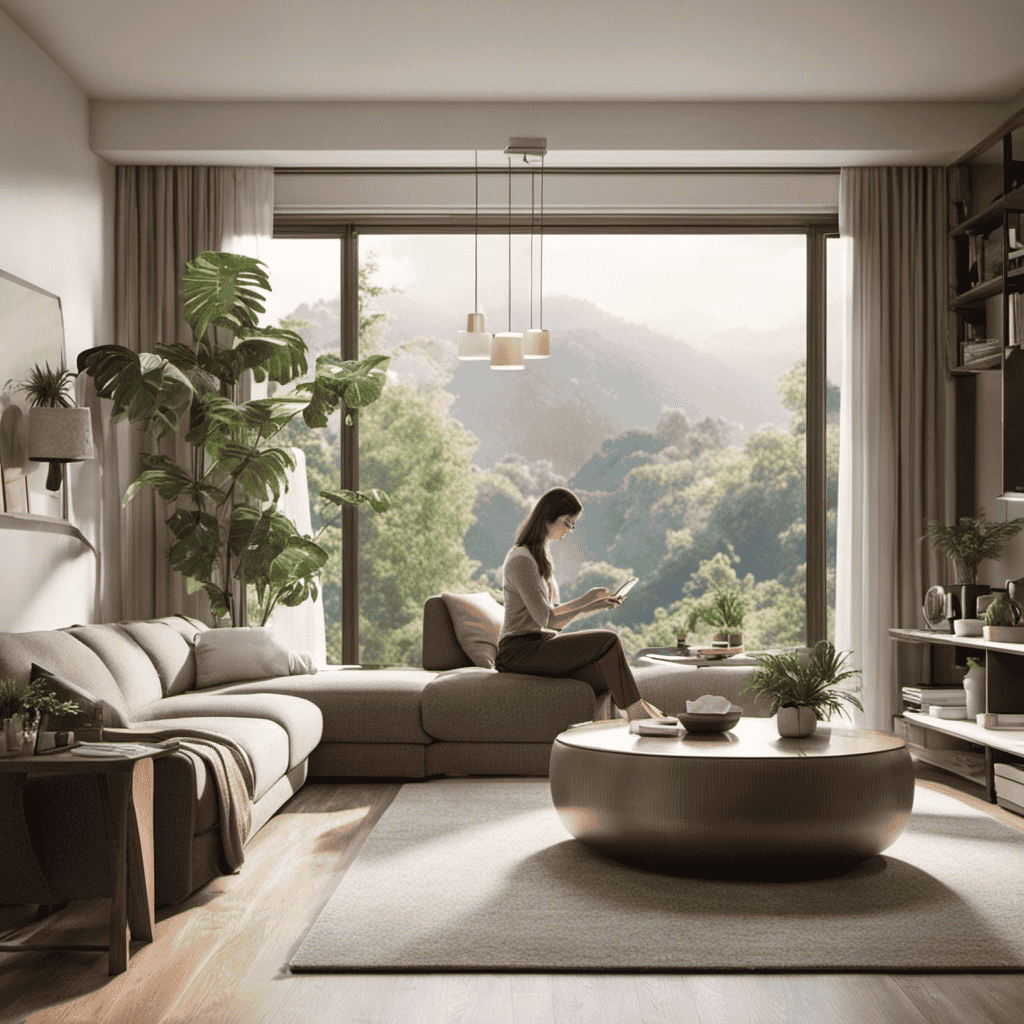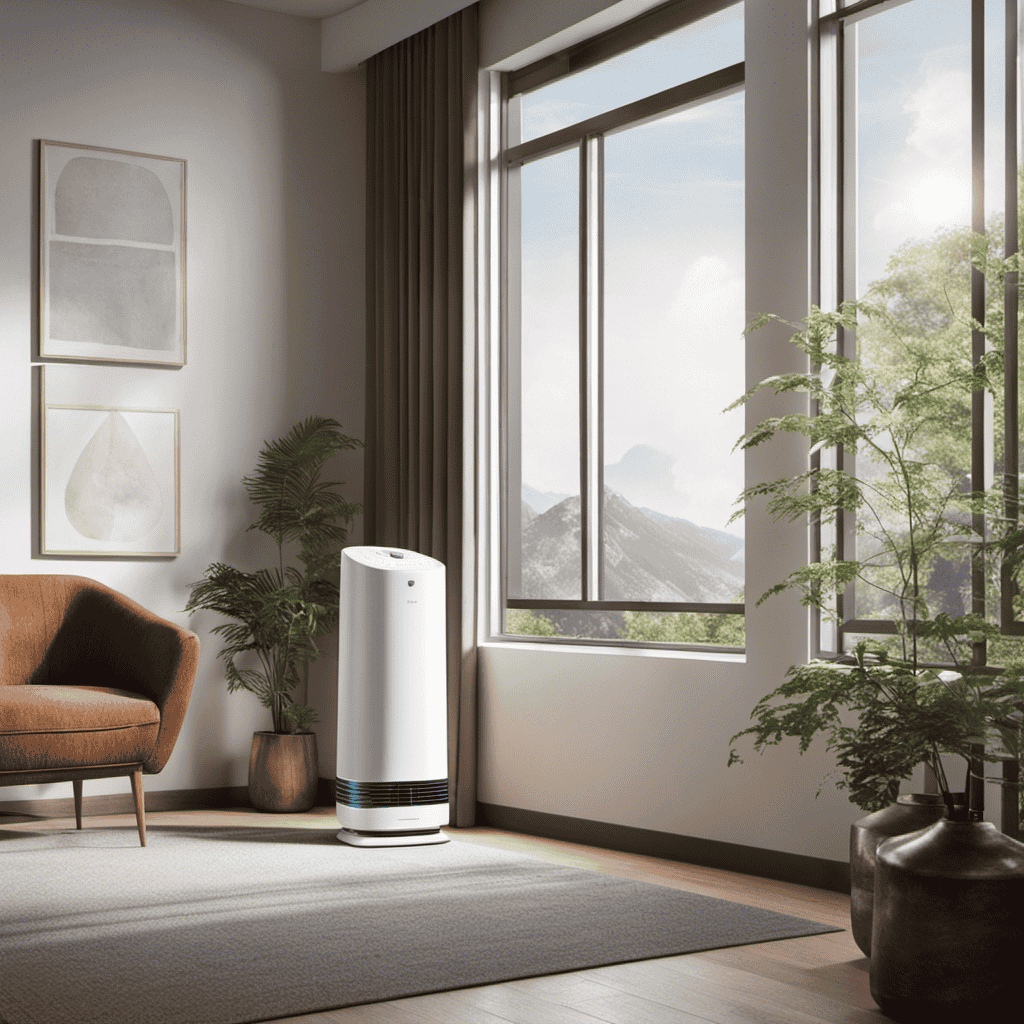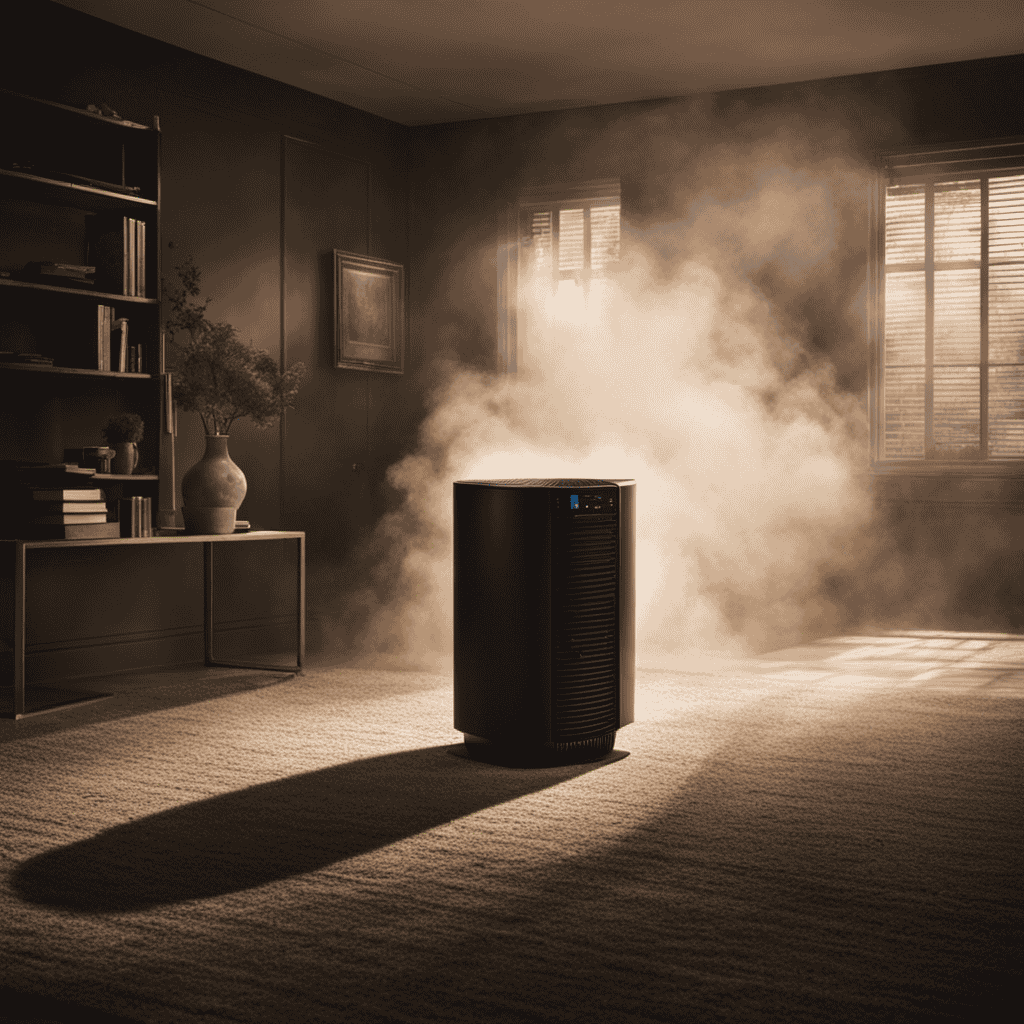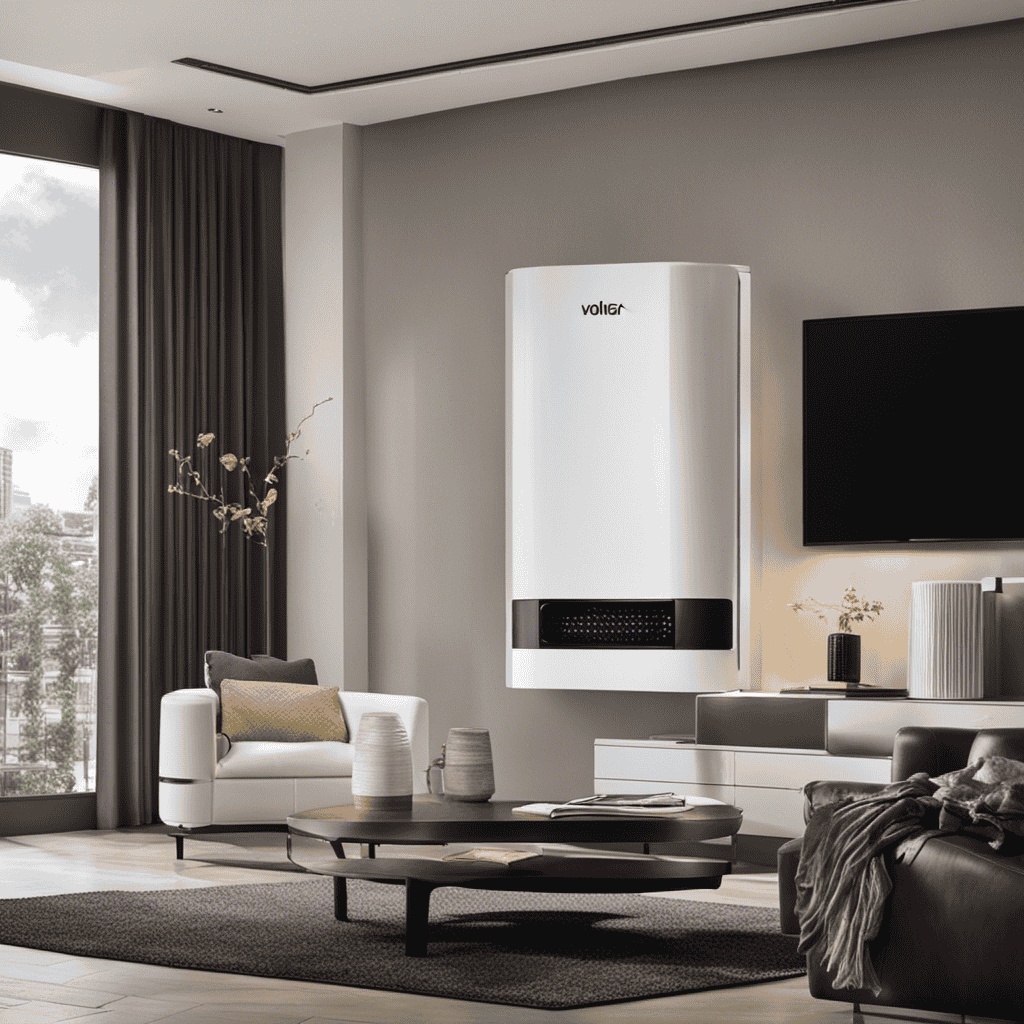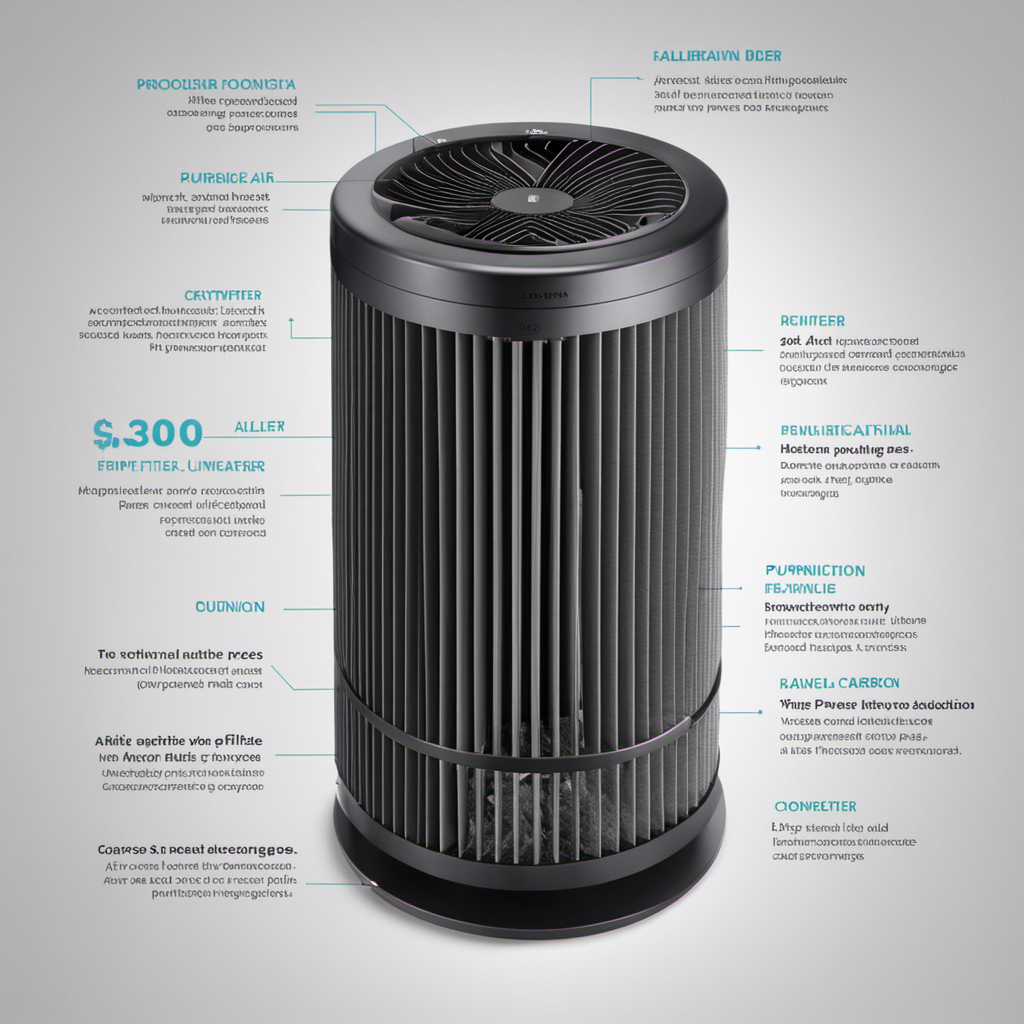As I explore the realm of air purifiers, I am pondering, ‘How much should I spend on an air purifier?’ With a multitude of choices out there, it can be daunting to discover the ideal one that fits my budget.
In this article, we will explore the factors to consider before making a purchase, the different types of air purifiers and their price range, and how to find the best value for money.
Let’s embark on this journey to breathe cleaner, fresher air without breaking the bank.
Key Takeaways
- Factors to consider before buying an air purifier include room size, filter type, noise level, and portability.
- The price range of air purifiers varies based on factors such as brand reputation, filtration system, unit size, and additional features.
- When assessing the cost-effectiveness of air purifiers, factors to consider include price vs. performance, CADR, filter replacement cost, energy efficiency, and long-term savings potential.
- The cost of air purifiers can vary depending on factors such as room size, features and filtration, brand reputation and warranty, affordability options, and long-term maintenance expenses.
Factors to Consider Before Buying an Air Purifier
Before you make a purchase, you should consider factors such as room size, filter type, and noise level when choosing an air purifier.
One important factor to consider is whether you need a portable or stationary air purifier. Portable air purifiers are smaller and can be moved from room to room, making them a convenient option. On the other hand, stationary air purifiers are larger and are designed to be placed in a specific room for long-term use.
Another factor to consider is the noise level versus the price. Some air purifiers can be quite noisy, especially when running at higher speeds. However, they may also be more affordable. It is essential to strike a balance between noise level and price to ensure you are getting the best value for your money.
Different Types of Air Purifiers and Their Price Range
There are various types of air purifiers available in the market, and their price range can differ significantly. When shopping for an air purifier, it’s important to consider the different brands and their price range, as well as the factors that affect air purifier prices. To give you an idea of the price range, here is a table showcasing some popular air purifier brands and their average prices:
| Brand | Price Range ($) |
|---|---|
| Dyson | $300 – $600 |
| Honeywell | $100 – $300 |
| Blueair | $200 – $500 |
| GermGuardian | $50 – $200 |
Factors that can affect the price of an air purifier include the type of filtration system used, the size of the unit, additional features like Wi-Fi connectivity or air quality sensors, and the brand reputation. Understanding the price range and factors influencing air purifier prices can help you make an informed decision when choosing the right air purifier for your needs.
Now that we have a better understanding of the different types of air purifiers and their price range, let’s dive into understanding the cost-effectiveness of these devices.
Understanding the Cost-Effectiveness of Air Purifiers
When it comes to choosing an air purifier, two key factors to consider are price and performance. It’s important to strike a balance between the cost of the unit and its effectiveness in improving indoor air quality.
Additionally, it’s worth exploring the long-term savings potential of an air purifier, as some models may require costly filter replacements or have higher energy consumption.
Price Vs. Performance
To get the best value for your money, consider the price versus the performance of the air purifier. It’s important to keep in mind that higher price doesn’t always mean better performance. Here are three factors to consider when doing a price comparison and performance rating of air purifiers:
-
CADR (Clean Air Delivery Rate): This measures the efficiency of the air purifier in removing pollutants from the air. Look for a higher CADR rating for better performance.
-
Filter Replacement Cost: Air purifiers usually require regular filter replacements. Consider the cost of these replacements when comparing prices. Cheaper air purifiers may have higher ongoing maintenance costs.
-
Energy Efficiency: Look for air purifiers with an Energy Star certification, as they are designed to use less energy while still providing good performance.
Long-Term Savings Potential
Considering the long-term savings potential, it’s worth looking for an air purifier with an Energy Star certification. Not only does this certification ensure energy efficiency, but it also indicates that the air purifier meets certain performance standards. When it comes to long-term health benefits, choosing an air purifier with low energy consumption is crucial. By analyzing the energy consumption of different models, you can make an informed decision that not only benefits your health but also saves you money in the long run. To help you with your search, here is a comparison table of three air purifiers with their energy consumption ratings:
| Air Purifier Model | Energy Consumption (Watts) | Energy Star Certified? |
|---|---|---|
| Model A | 50 | Yes |
| Model B | 70 | No |
| Model C | 40 | Yes |
As you can see, Model A and Model C are Energy Star certified, meaning they consume less energy and are more cost-effective over time. It’s important to consider both the long-term health benefits and the energy consumption analysis when investing in an air purifier.
Budget-Friendly Air Purifiers for Small Spaces
There are affordable air purifiers available for smaller areas. When it comes to finding cost-effective options for air purification, there are a few affordable solutions that are worth considering:
-
Compact and Portable Models: These air purifiers are designed specifically for smaller spaces such as bedrooms, offices, or dorm rooms. They are compact in size and offer effective air purification without breaking the bank.
-
Filter Replacement Costs: Consider air purifiers that have affordable filter replacements. Some models have filters that need to be replaced frequently, which can add up in cost over time. Look for air purifiers that offer affordable replacement filters to ensure long-term affordability.
-
Energy Efficiency: Look for air purifiers that are energy efficient. Energy-efficient models not only help you save on your electricity bill but also ensure that your purification solution is cost-effective in the long run.
Mid-Range Air Purifiers With Advanced Features
You can find mid-range air purifiers with advanced features that offer excellent value for your money. These air purifiers are equipped with the latest air purifier technology, ensuring efficient and effective purification of the air in your home.
They often come with HEPA filters, which can capture up to 99.97% of airborne particles, including dust, pollen, pet dander, and even certain viruses. Additionally, these mid-range air purifiers may have features such as air quality sensors, auto mode, and timers, allowing you to customize and optimize the purification process.
When it comes to air purifier maintenance, it is essential to regularly clean or replace the filters to maintain optimal performance. Most mid-range air purifiers will have indicator lights or reminders to help you keep track of when to perform this maintenance task.
Overall, investing in a mid-range air purifier with advanced features can provide you with cleaner and healthier air in your home.
High-End Air Purifiers for Large Areas and Allergen Removal
When it comes to high-end air purifiers for large areas and allergen removal, two key factors to consider are cost versus performance and allergen elimination effectiveness.
It’s important to find a balance between the price of the air purifier and its performance capabilities. Additionally, the effectiveness of the air purifier in removing allergens such as dust, pollen, and pet dander should be a top priority for those with allergies or respiratory issues.
Cost Vs. Performance
The cost of an air purifier will vary depending on its performance. When considering the cost effectiveness of an air purifier, there are several factors to take into account. Here are three key considerations:
-
Room size: The size of the room where you plan to use the air purifier will affect the cost. Larger rooms require more powerful purifiers, which usually come with a higher price tag. It’s important to choose an air purifier that is suitable for the room size to ensure optimal performance and efficiency.
-
Features and filtration: Different air purifiers offer various features and filtration systems. HEPA filters are highly effective at removing allergens, but they tend to be more expensive. Consider the specific needs of your household and prioritize features accordingly.
-
Brand reputation and warranty: Established brands often come with a higher price, but they also offer better reliability and customer support. Additionally, a longer warranty period can provide peace of mind and protect your investment.
When looking for affordability options, consider researching and comparing different brands and models to find the best cost-effective option for your specific needs.
Allergen Elimination Effectiveness
In the previous subtopic, we discussed the cost and performance of air purifiers. Now, let’s delve into the effectiveness of air purifiers in removing allergens from the air. Allergens are substances that can cause allergic reactions in sensitive individuals. Air purifiers use various techniques to eliminate allergens and improve indoor air quality. Some common allergen removal techniques include HEPA filtration, activated carbon filters, and UV-C light sterilization.
To better understand the effectiveness of air purifiers in allergen removal, let’s take a look at the table below:
| Allergen Removal Technique | Effectiveness |
|---|---|
| HEPA Filtration | High |
| Activated Carbon Filters | Moderate |
| UV-C Light Sterilization | Low |
HEPA filtration is considered highly effective in capturing allergens such as pollen, pet dander, and dust mites. Activated carbon filters can help remove odors and certain chemicals, but their effectiveness in eliminating allergens is moderate. UV-C light sterilization, although effective against some bacteria and viruses, has limited effectiveness in allergen removal. It is important to consider the specific allergens you are targeting and choose an air purifier with the appropriate filtration system for optimal results.
Comparing the Price and Performance of Air Purifiers
To find the best air purifier for you, compare the price and performance of different models. When it comes to buying an air purifier, it’s important to consider both the cost and its effectiveness.
Here are three factors to consider in your price comparison and performance analysis:
-
Air cleaning capacity: Look for an air purifier that can effectively clean the air in your desired room size. Consider the Clean Air Delivery Rate (CADR) and the recommended room size mentioned by the manufacturer.
-
Filter replacement costs: Most air purifiers require regular filter replacements. Compare the costs of replacement filters and how frequently they need to be replaced. This will give you a better idea of the long-term maintenance expenses.
-
Energy efficiency: Check the energy consumption of different models. Look for air purifiers that are Energy Star certified, as they are designed to be more energy-efficient and can help you save on electricity bills.
The Impact of Filter Replacements on Air Purifier Costs
When comparing different models, don’t forget to factor in the costs of regularly replacing filters, as this can significantly impact the overall expenses of your air purification system.
The filter lifespan and maintenance cost are important factors to consider when evaluating the long-term affordability of an air purifier. Filters typically need to be replaced every 6 to 12 months, depending on the model and usage.
It is essential to check the manufacturer’s recommendations for filter replacement and calculate the associated costs over time. Some filters may be more expensive or harder to find, which can add to the maintenance expenses.
It is advisable to choose an air purifier with readily available and reasonably priced filters to ensure cost-effective operation.
Cost-Saving Tips for Buying and Maintaining an Air Purifier
One way to save on expenses when purchasing and maintaining an air purifier is by opting for models with affordable and easily accessible filters. Here are three cost-saving tips to consider:
-
Research different air purifier models: Look for options that not only fit your budget but also have filters that are reasonably priced. Compare prices and read reviews to find the best value for your money.
-
Consider filter lifespan: Some air purifiers require frequent filter replacements, which can quickly add up in costs. Look for models with longer filter lifespans to minimize ongoing expenses.
-
Energy-efficient options: Energy-efficient air purifiers not only help save on electricity bills but also reduce overall maintenance costs. Look for models with Energy Star certification or low energy consumption ratings.
By following these cost-saving tips and choosing energy-efficient air purifiers, you can enjoy cleaner air while keeping your expenses in check.
Now, let’s explore the long-term savings with energy-efficient air purifiers.
Long-Term Savings With Energy-Efficient Air Purifiers
When it comes to air purifiers, two important factors to consider are cost and efficiency. Finding the right balance between these two can help you save money in the long run.
Additionally, energy-efficient air purifiers not only provide cost savings but also offer environmental benefits by reducing energy consumption and minimizing their carbon footprint.
Cost Vs. Efficiency
The cost of an air purifier doesn’t always reflect its efficiency. When it comes to choosing the right air purifier for your needs, it’s important to consider cost effectiveness and compare prices before making a purchase.
Here are three factors to consider when comparing the price and efficiency of air purifiers:
-
Filter lifespan: Look for air purifiers with longer-lasting filters. While they may have a higher upfront cost, they can save you money in the long run by reducing the frequency of filter replacements.
-
Energy consumption: Consider the energy efficiency of the air purifier. Look for models that are Energy Star certified, as they consume less energy and can help lower your electricity bills.
-
Coverage area: Evaluate the square footage that the air purifier can effectively clean. A larger coverage area means you can potentially use fewer units, which can save you money upfront.
Environmental Benefits
Consider the environmental benefits of choosing an energy-efficient air purifier. It can help reduce your carbon footprint and contribute to a healthier planet. Energy consumption is an important factor to consider when purchasing an air purifier. It directly affects both the environment and your electricity bills. Opting for an energy-efficient model can significantly lower your energy usage, resulting in reduced greenhouse gas emissions.
Additionally, energy-efficient air purifiers often come with advanced technology that maximizes air cleaning efficiency while minimizing noise levels. This means you can enjoy cleaner air without the inconvenience of excessive noise.
By choosing an energy-efficient air purifier, you are not only improving the air quality in your home but also making a positive impact on the environment.
Now, let’s explore how to find the best value for money when purchasing an air purifier.
How to Find the Best Value for Money When Purchasing an Air Purifier
To get the best value for your money, it’s important to compare prices and features of different air purifiers. When looking for cost-saving tips and energy-efficient options, consider the following:
-
Look for Energy Star certification: Air purifiers with this certification are designed to use less energy, which can help lower your electricity bills in the long run. Additionally, Energy Star certified appliances are typically more environmentally friendly.
-
Consider the filter replacement costs: Some air purifiers require frequent filter replacements, which can add up over time. Look for models with reusable or washable filters to save on ongoing maintenance costs.
-
Assess the coverage area: Make sure to choose an air purifier that is suitable for the size of the room you intend to use it in. Buying an oversized purifier can result in unnecessary energy consumption, while an undersized one may not effectively clean the air.
Conclusion
In conclusion, it’s important to find an air purifier that suits your needs and budget. By understanding the different types of air purifiers and their price ranges, you can make an informed decision.
Additionally, considering the long-term cost-effectiveness, filter replacements, and energy efficiency can help you save money in the long run.
Remember, finding the best value for money is crucial, so take your time and choose wisely.
Happy purifying!
